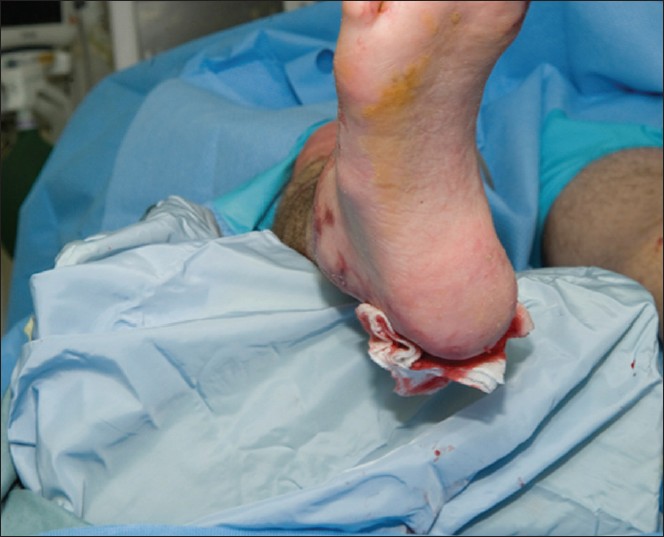|


 |
| LETTER TO EDITOR |
|
| Year : 2014 | Volume
: 6
| Issue : 2 | Page : 70-71 |
|
|
A useful adjunct in lower limb surgery
Zeeshan Ahmad1, Marcus J Davies2
1 Department of Plastic Surgery, UHCW, Coventry, Warks, CV2 2BF, United Kingdom
2 Department of Plastic Surgery, QVH, East Grinstead, East Sussex, United Kingdom
| Date of Web Publication | 18-Dec-2014 |
Correspondence Address:
Zeeshan Ahmad
Department of Plastic Surgery, UHCW, Coventry, Warks, CV2 2BF
United Kingdom
 Source of Support: None, Conflict of Interest: None
DOI: 10.4103/2006-8808.147266

How to cite this article:
Ahmad Z, Davies MJ. A useful adjunct in lower limb surgery
. J Surg Tech Case Report 2014;6:70-1 |
Sir,
Traditionally in certain cases for instance in plastic surgery, SHOs are tasked with harvested skin grafts, applying plaster casts and closing donor sites, as well as providing important assistance in the retraction of tissues. As SHOs are less commonly seen in the theater compared to bygone years. [1] The senior author has developed a novel and useful technique for performing surgery in areas where typically an SHO could provide useful assistance [Figure 1], [Figure 2], [Figure 3]. | Figure 3: Bin placed under lower limb for better exposure, support and positioning
Click here to view |
Through use of a sterile Mayo cover, an empty, un-used sharps bin is placed into it. The surgeon then wraps the bin in the cover such that full sterility in maintained. The device can then be used to prop up legs or arms when performing surgery with the knowledge that the limb is elevated and secure, whilst maintaining good surgical access in a sterile fashion.
Having juniors in theater is very important for the future of the surgery, as well as for the operating surgeon, especially where assistance may be needed. Not having juniors present adds to operating time, limits training and teaching opportunities and also increases the operating surgeon's fatigue. [1] This adjunct can aide better positioning for the lower limb and facilitates safe [2] and efficient surgery.
 References References | |  |
| 1. | Ahmed M, Arora S, Tiew S, Hayden J, Sevdalis N, Vincent C, et al. Building a safer foundation: The lessons learnt patient safety training programme. BMJ Qual Saf 2014;23:78-86.  |
| 2. | Five Steps to Safer Surgery, National Patient Safety Agency. Available from: http://www.patientsafetyfirst.nhs.uk/ashx/Asset.ashx?path=/How-to-guides-2008-09-19/NRLS-1291-How_to_guide_fi ~ urgery-2010.12.20-v1%5B1%5D.pdf. [Last accessed on 20 Sep 2013].  |
[Figure 1], [Figure 2], [Figure 3]
|